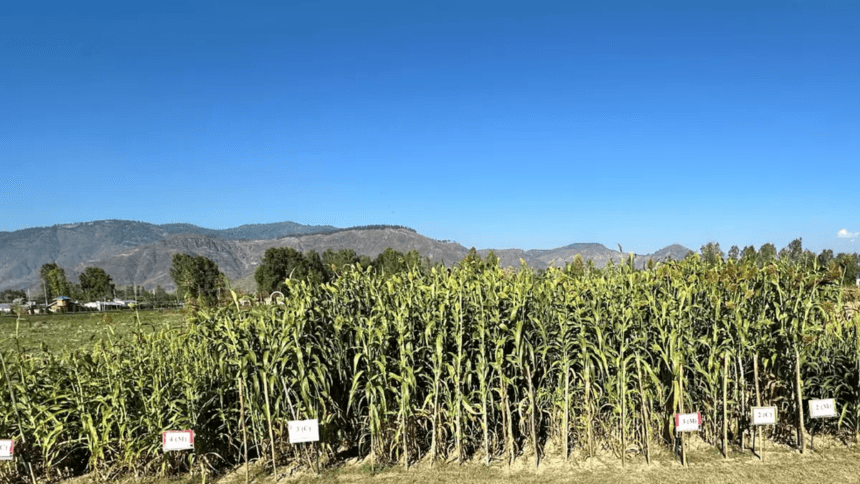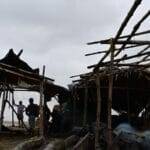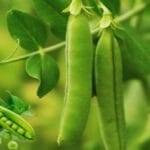Main Points In Hindi (मुख्य बातें – हिंदी में)
-
नई फसल का आगमन: जम्मू और कश्मीर के ठंडे क्षेत्रों में 2025 में ज्वार की एक नई फसल शुरू होने जा रही है, जो अधिकतर सूखी भूमि में उगाई जाने वाली फसल है और ठंडे तापमान के लिए विशेष रूप से विकसित की गई है।
-
संस्थान का सहयोग: इस परियोजना को शेर-ए-कश्मीर यूनिवर्सिटी ऑफ एग्रीकल्चरल साइंसेज एंड टेक्नोलॉजी (SKUAST) और अंतर्राष्ट्रीय फसल अनुसंधान संस्थान (ICRISAT) ने मिलकर विकसित किया है। उन्होंने ठंड-संवेदनशील ज्वार की किस्में विकसित की हैं जो कश्मीर घाटी की अनोखी कृषि-जलवायु परिस्थितियों में फलने-फूलने के लिए अनुकूलित हैं।
-
पशुधन के लिए लाभ: यह ज्वार की किस्में अनाज और चारे दोनों प्रदान करती हैं, जिससे कश्मीर में चारे की मौजूदा 40% कमी को दूर करने में मदद मिलेगी। यह पशुधन उत्पादकता और किसानों की आय में सुधार लाने के लिए महत्वपूर्ण है।
-
आर्थिक विकास और खाद्य सुरक्षा: उच्च उपज देने वाली पौष्टिक ज्वार की किस्मों की शुरुआत से कृषि परिदृश्य में बदलाव आएगा, ग्रामीण अर्थव्यवस्था को बढ़ावा मिलेगा और खाद्य सुरक्षा में सुधार होगा, खासकर हाशिए पर रहने वाले समुदायों के लिए।
- समाजिक-आर्थिक सुधार की उम्मीद: इस परियोजना का लक्ष्य कश्मीर घाटी में हाशिए पर रहे किसानों की सामाजिक-आर्थिक स्थितियों में सुधार लाना है, जिससे चारा, चारा और आजीविका सुरक्षा हासिल हो सकेगी।
Main Points In English(मुख्य बातें – अंग्रेज़ी में)
Here are the main points from the provided text regarding the introduction of cold-resistant sorghum in Jammu and Kashmir:
-
Introduction of Sorghum: Jammu and Kashmir is set to welcome a new crop, sorghum, in 2025. Traditionally grown in warmer climates, this drought-resistant crop has been successfully adapted to the cold temperatures of the region, representing a significant agricultural achievement.
-
Collaboration for Development: The development of these cold-resistant sorghum varieties is a joint effort between the Sher-e-Kashmir University of Agricultural Sciences and Technology (SKUAST) and the International Crops Research Institute for the Semi-Arid Tropics (ICRISAT). Through rigorous research and field trials, specific varieties suitable for the unique agro-climatic conditions of the Kashmir Valley have been developed.
-
Impact on Local Economy: This initiative aims to transform the agricultural landscape and improve the livelihoods of farmers in the region. The dual-purpose sorghum varieties will provide both grain and fodder, addressing the significant fodder shortage (currently at 40%) that affects livestock productivity and farmer income, especially for marginalized communities.
-
Boosting Food Security: The introduction of high-yielding and nutritious sorghum varieties, with biomass production reaching up to 50 tons per hectare, is expected to bridge the fodder gap, enhance the rural economy, and improve food security.
- Focus on Sustainability: The project’s objective also includes promoting sustainable livestock production and improving the socio-economic conditions of marginalized farmers in the Kashmir Valley by releasing these cold-tolerant sorghum varieties by 2025.


Complete News In Hindi(पूरी खबर – हिंदी में)
एक अभूतपूर्व विकास में, जम्मू और कश्मीर के ठंडे इलाके 2025 में एक नई फसल का स्वागत करने के लिए तैयार हैं – ज्वार, जो मुख्य रूप से शुष्क भूमि की फसल है। परंपरागत रूप से गर्म जलवायु में उगाई जाने वाली यह कठोर, सूखा-प्रतिरोधी फसल, क्षेत्र के ठंडे तापमान के लिए सफलतापूर्वक अनुकूलित हो गई है, जो एक महत्वपूर्ण कृषि सफलता का प्रतीक है।
शेर-ए-कश्मीर यूनिवर्सिटी ऑफ एग्रीकल्चरल साइंसेज एंड टेक्नोलॉजी (SKUAST), कश्मीर के सहयोग से अर्ध-शुष्क उष्णकटिबंधीय के लिए अंतर्राष्ट्रीय फसल अनुसंधान संस्थान (ICRISAT) ने संयुक्त रूप से इन ठंड प्रतिरोधी ज्वार की किस्मों को विकसित करने के लिए इस परियोजना पर काम किया है। .
कठोर अनुसंधान और खेत पर परीक्षणों के माध्यम से, उन्होंने विशिष्ट ज्वार की किस्में विकसित की हैं जो कश्मीर घाटी की अद्वितीय कृषि-जलवायु परिस्थितियों में पनप सकती हैं।
- यह भी पढ़ें: सीसीआई ने 2024-25 सीज़न के लिए तेलंगाना से एमएसपी पर कपास की खरीद शुरू की
यह सफलता सिर्फ एक नई फसल लाने के बारे में नहीं है; यह कृषि परिदृश्य को बदलने और क्षेत्र में किसानों की आजीविका को ऊपर उठाने के बारे में है। दोहरे उद्देश्य वाली ज्वार की किस्में, जो अनाज और चारा दोनों प्रदान करती हैं, का उद्देश्य क्षेत्र के पशुधन क्षेत्र में महत्वपूर्ण चारे की कमी को दूर करना है, जो स्थानीय अर्थव्यवस्था का एक महत्वपूर्ण स्तंभ है।
वर्तमान में, कश्मीर में 40% चारे की कमी है, जिससे पशुधन उत्पादकता और किसानों की आय प्रभावित हो रही है, खासकर हाशिये पर रहने वाले समुदायों के किसानों की। 50 टन प्रति हेक्टेयर तक बायोमास उत्पादन के साथ उच्च उपज देने वाली, पौष्टिक ज्वार की किस्मों की शुरूआत से इस अंतर को पाटने, ग्रामीण अर्थव्यवस्था को बढ़ावा देने और खाद्य सुरक्षा बढ़ाने की उम्मीद है।
- यह भी पढ़ें: सतत खेती: भारत की कार्बन क्रेडिट क्षमता को अनलॉक करने की कुंजी
आईसीआरआईएसएटी में प्रधान वैज्ञानिक – सोरघम ब्रीडिंग, एफ़्रेम हब्यारिमाना ने सोमवार को यहां कहा, “कश्मीर की उच्च-ऊंचाई वाली पारिस्थितिकी के अनुरूप विशिष्ट ज्वार श्रृंखला विकसित करना एक उल्लेखनीय उपलब्धि है जो 40 डिग्री अक्षांश के उत्तर में खेती का विस्तार करने के हमारे प्रयासों को आगे बढ़ाएगी।” सफलता पर टिप्पणी कर रहे हैं।
परियोजना का लक्ष्य 2025 में इन ठंड-सहिष्णु ज्वार की किस्मों को जारी करके स्थायी पशुधन उत्पादन को बढ़ाना और कश्मीर घाटी में हाशिए पर रहने वाले किसानों की सामाजिक-आर्थिक स्थितियों में सुधार करना है।
- यह भी पढ़ें: सिकुड़ते केसर के खेतों के बीच कश्मीरी केसर के खेतों को पुनर्जीवित करना
SKUAST कश्मीर के कुलपति नजीर ए गनई ने एक बयान में कहा, “यह चारा, चारा और आजीविका सुरक्षा हासिल करने की दिशा में एक महत्वपूर्ण कदम है, खासकर ऊंचाई वाले इलाकों में वंचित आदिवासी समुदायों के लिए।”
Complete News In English(पूरी खबर – अंग्रेज़ी में)
In an unprecedented development, the cold regions of Jammu and Kashmir are set to welcome a new crop in 2025 – sorghum, which is primarily a dryland crop. Traditionally grown in warmer climates, this hardy, drought-resistant crop has successfully adapted to the cold temperatures of the region, marking a significant agricultural achievement.
The Sher-e-Kashmir University of Agricultural Sciences and Technology (SKUAST), in collaboration with the International Crops Research Institute for the Semi-Arid Tropics (ICRISAT), has been working on a project to develop these cold-resistant varieties of sorghum.
Through extensive research and field testing, they have developed specific sorghum varieties that can thrive in the unique agricultural and climatic conditions of the Kashmir Valley.


This success is not just about introducing a new crop; it aims to transform the agricultural landscape and uplift the livelihoods of farmers in the region. The dual-purpose sorghum varieties, which provide both grain and fodder, are designed to address the critical shortage of fodder in the local livestock sector, a crucial pillar of the local economy.
Currently, Kashmir faces a 40% deficit in fodder, which negatively impacts livestock productivity and the income of farmers, particularly those from marginalized communities. The introduction of high-yielding, nutritious sorghum varieties that can produce up to 50 tons of biomass per hectare is expected to bridge this gap, enhance the rural economy, and improve food security.
A senior scientist in sorghum breeding at ICRISAT, Afrim Hubyarimana, mentioned that developing specific sorghum lines tailored to the high-altitude ecosystem of Kashmir is a remarkable achievement that further pushes efforts to expand farming north of the 40-degree latitude.
The objective of the project is to release these cold-tolerant sorghum varieties in 2025 to boost sustainable livestock production and improve the socio-economic conditions of marginalized farmers in the Kashmir Valley.
The Vice Chancellor of SKUAST Kashmir, Nazir A. Ganai, stated that this initiative is a significant step toward achieving fodder and livelihood security, especially for the disadvantaged tribal communities in high-altitude areas.
Source link








